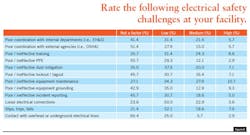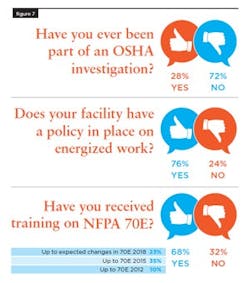2018 electrical safety survey results: Is your plant a safe plant? Part 2
Plant Services readers have regularly weighed in on two key research topics – predictive maintenance programs and workforce issues. Your responses have shed additional light on actions and attitudes that are going on in real time on your plant floor. For 2018, the Plant Services editors wanted to add a third research project into the mix, and the choice of topic was an easy one to make: electrical safety. No other topic is as key to plant best practices as safety or as important to team morale. And in terms of electrical safety specifically, few other plant hazards are as sudden or as invisible as electrical risks, especially arc flash. In fact, close to one-quarter of survey respondents said that they had been involved in an arc flash event, and 60% reported knowing someone who has been involved in such an event.
Future follow-up surveys will help reveal electrical safety trends over time; for now, the data provide an insightful and current snapshot of electrical safety in the places where you spend a large chunk of your time.
Here’s hoping your plant is a safe plant.
Electrical safety challenges
For Plant Services readers, the results shown above in Figure 6 are especially worth noting. Of the safety challenges listed as options in this year’s survey, the top trouble spot when it comes to electrical safety is poor or ineffective equipment maintenance, with almost 11% of respondents rating it as a high challenge.
In fact, when the “medium” and “high” categories are combined, two challenges emerge as most pressing: (1) poor or ineffective equipment maintenance, 39%; and (2) poor or ineffective training, at 33%. (Equipment grounding was close behind maintenance in the “high” category at 9.3%, but fewer respondents considered it a medium challenge.)
On the maintenance side, the survey asked about the type of predictive maintenance program currently in place, with respondents indicating that they were using a combination of methods to monitor their electrical systems. The four most-used technologies are IR thermography (72%), oil analysis (70%), motor testing (67%), and vibration analysis (65%), with predictive modeling cited as the currently least-used method (16%).
Two additional survey questions help add context to respondents’ concern over training. The first question asked about the frequency of training, and 10% of respondents indicated that training is not required at all at their facility. A further 27% indicated that training is required no more than every two years. The better news is that a comfortable majority (56%) reported that they are required to take annual training, such as an OSHA refresher course; in addition, 7.4% of respondents engage in quarterly training.
The survey also asked about types of training methods, with 71% of respondents indicating that traditional on-site technical training is employed, about 56% reporting the use of online courses or webinars, and 10% reporting that augmented or virtual reality is now being used at their facility.
The good news is that three challenges are clearly at the bottom of the list: poor coordination with external agencies such as OSHA (21%), poor or ineffective PPE (15%), and contact with overhead or underground electrical lines (9%).
When asked an open-ended question about the one thing they would do to improve electrical safety, respondents reported the following:
- “Training for nontechnical team members on their electrical safety, how to recognize hazards and avoid them.”
- “Teach everyone in the facility about the dangers of electricity. This could be just as useful at home as it is at work. Most employees don’t understand the dangers involved in electricity.”
- “Make sure technicians understand the culture-of-safety value, through considering the value of what this contributes inside the organization.”
- “Update disconnects and starters.”
- “Modernize with new technology.”
- “Find improved devices for wash-down areas.”
- “Need more training on test procedures.”
- “Getting trained and updated on new electrical safety codes.”
- “Re-enactment of near misses.”
- “Include a simple one-page laminated card that indicates the areas of high electrical danger.”
- “Replace old and worn out MCCs.”
- “Learn and use ultrasonic technology.”
- “Do an arc flash study, but upper management will not fund.”
- “Better guarding, consistently applied at every station. Set up a formal training program for OSHA and NFPA 70E. Safety training requiring passing the course and enforcement of PPE rules and LOTO rules.”
Incidents and training
The final section of the survey asked about electrical incidents at your facility as well as your facility’s policies on energized work and the types of training available. As noted on Figure 5, about 25% of respondents indicated that it had been six months or less since their last electrical incident.
Figure 7 provides some background data that adds context to responses about the frequency of electrical incidents. Specifically, 28% of respondents also have been part of an OSHA investigation, and 28% also said that their facilities have either an informal near-miss reporting program or none at all.
On the question of whether your facility has a policy in place on energized work, 24% responded “no.” For those that do have policies in place, the vast majority of respondents (85%) indicated that the policy was communicated during training, with the remaining 15% balanced between online and public notices (email, bulletin boards, plastic sheets).
Finally, it was striking that the share of respondents who reported no training on NFPA 70E was 33%. The better news is that about 23% of respondents had already been trained by the end of last year on expected changes in 70E 2018.
The survey also asked four specific questions on arc flash training and incidents; all are captured in Figure 8. It’s interesting to note that ARC flash studies are performed on gear far less often than training on ARC flash is provided to respondents; as one respondent mentioned earlier, budgetary constraints may play a role here.
For this first Electrical Safety survey, we also added two questions on whether you (23%) or someone you know (60%) has been involved in an arc flash incident, and these data also are reported in Figure 8. However, as one respondent noted, both of these questions would deliver more insight if further options were available for respondents to select beyond “yes” and “no”; for example, these options could include whether or not the incident involved people, or people but no injuries, or incidents with lost time.
If you’re interested in viewing the full data set, please download it at http://plnt.sv/1802-ES, and then consider sending your thoughts to [email protected]. We will be preparing an industry feedback article on this survey that will appear a future issue, and we would value your insights.
About the Author

Thomas Wilk
editor in chief
Thomas Wilk joined Plant Services as editor in chief in 2014. Previously, Wilk was content strategist / mobile media manager at Panduit. Prior to Panduit, Tom was lead editor for Battelle Memorial Institute's Environmental Restoration team, and taught business and technical writing at Ohio State University for eight years. Tom holds a BA from the University of Illinois and an MA from Ohio State University



